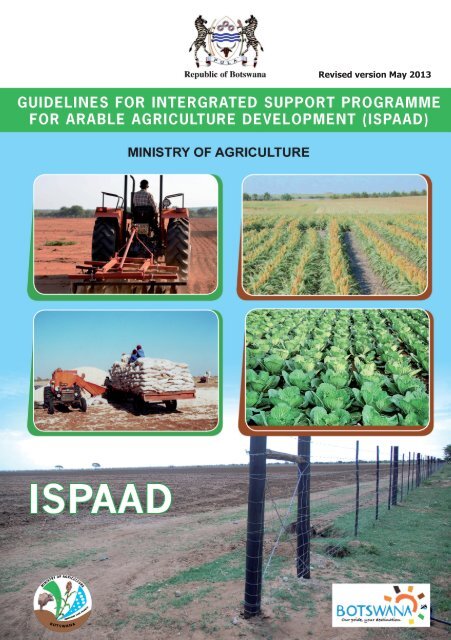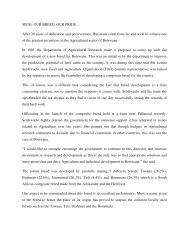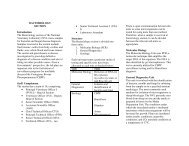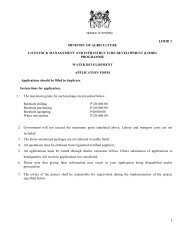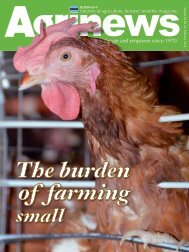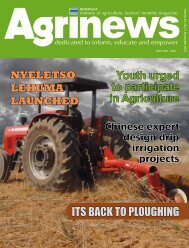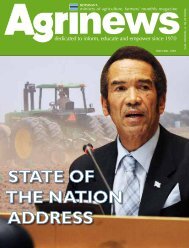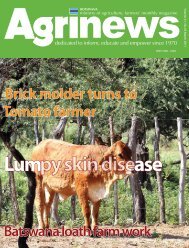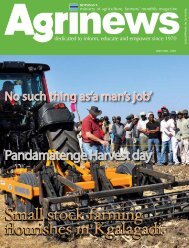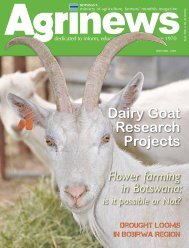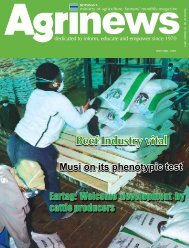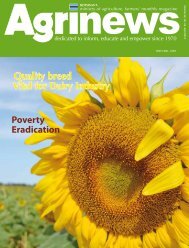guidelines were reviewed - Ministry of Agriculture
guidelines were reviewed - Ministry of Agriculture
guidelines were reviewed - Ministry of Agriculture
- No tags were found...
You also want an ePaper? Increase the reach of your titles
YUMPU automatically turns print PDFs into web optimized ePapers that Google loves.
1.0 INTRODUCTIONThe Integrated Support Programme for Arable <strong>Agriculture</strong> Development(ISPAAD) was introduced in 2008 to address challenges facing arablefarmers. It was envisaged that the performance <strong>of</strong> the arable sub-sectorwould be greatly improved by fencing fields, establishing AgriculturalService Centers as well as assisting arable farmers to acquire requisiteinputs and draught power to undertake tillage operations.The components <strong>of</strong> ISPAAD include: Provision <strong>of</strong> Draught Power, PotableWater, Seeds, Fertilizers and Herbicides, Facilitation <strong>of</strong> access to Creditand Fencing and Establishment <strong>of</strong> Agricultural Service Centres,.Farmers are categorised and subsidised according to the area <strong>of</strong>production and level <strong>of</strong> operation.2.0 Subsistence Farmers2.1 Subsistence farmers cultivate up to a maximum <strong>of</strong> 16Ha.These farmers use small equipment that is suitable for theirarea <strong>of</strong> production.2.2 Farmers under this category will be assisted with 100%subsidy for hybrid seed to cover a maximum <strong>of</strong> 5Ha andopen pollinated seeds to cover the remaining hectarage toa maximum <strong>of</strong> 16 Ha. If a farmer opts for open pollinatedseeds only, he/she will be assisted at 100% seed subsidy toa maximum <strong>of</strong> 16ha.2.3 Farmers will be assisted with free fertilizer to cover up to 5Hafor either <strong>of</strong> the following treatments; liming, basal or topdressing.2.4 Farmers will be assisted with free herbicides to control weedsup to 5Ha for either <strong>of</strong> the following operations;• Pre emergence• Post emergence• or control <strong>of</strong> difficult weeds such as Cynodon dactylon,mokhure etc.1 ISPAAD GUIDELINES
2.5 Farmers will be assisted with 100% subsidy for ploughingand row planting up to a maximum <strong>of</strong> 5ha. Where necessaryfarmers will be assisted with 100% subsidy on harrowing fora maximum <strong>of</strong> 5Ha.2.6 Seed is provided for varieties <strong>of</strong> major grain and foddercrops, sorghum, maize, millet and cowpeas only. Assortedseeds will be provided at seeding rates shown below:CROPKG/HASorghum 3Maize 10Millet 2cowpeas 10-15Lablab 12 - 13Other fodder cropsAs recommendedThe amount <strong>of</strong> seed issued to farmers will depend onavailability, and suitability to the farming areas.Hybrid seeds, Fertilizer, Herbicides and draft power will beprovided to farmers who row plant.2.7 Private contractors will be engaged to plough and row plantand harrow for farmers under the following conditions:• All contractors shall register with the Extension Staff atthe latest by 30th October every year.• Contractors are encouraged to have a full range <strong>of</strong> farmingimplements <strong>of</strong> good quality such as plough, planter, anda harrow.• ISPAAD will pay for ploughing and row plantingirrespective <strong>of</strong> whether the farmer used a tractor oranimal draft power as long as the seedbed preparation is<strong>of</strong> acceptable standard.• When ploughing and row planting is completed, farmersISPAAD GUIDELINES 2
and their contractors should fill in a practical completioncertificate within seven (7) days after verification by theField Staff.• The Department <strong>of</strong> Crop Production shall only pay aftervalidation <strong>of</strong> the work done (i.e. area ploughed androw planted). It is the responsibility <strong>of</strong> beneficiaries <strong>of</strong>ISPAAD to ensure that their draught power contractorsplough and row plant their fields to acceptable standards.The Department reserves the right to reject claims forpayment <strong>of</strong> any fields that are poorly ploughed and rowplanted.• Draught power providers who do not satisfy therequirement in terms <strong>of</strong> the quality <strong>of</strong> the seedbedpreparation would be disqualified for future participationunder ISPAAD.The rates for ploughing row planting operations are asfollows:- Ploughing and row planting P800.00/ha Minimum tillageP500.00/ha Harrowing (where applicable) P360.00/haThese rates shall be <strong>reviewed</strong> from time to time and adjustedaccordingly.3.0 EMERGING FARMERSEmerging farmers cultivate up to a maximum <strong>of</strong> 150Ha.These farmersuse medium size equipment for their operation.3.1 Farmers under this category will be assisted with 35 %subsidy on the cost <strong>of</strong> hybrid or open pollinated varieties <strong>of</strong>seeds up to a maximum <strong>of</strong> 150 Ha.3.2 Farmers will be assisted with 35% subsidy on the cost <strong>of</strong>3 ISPAAD GUIDELINES
fertilizer up to a maximum <strong>of</strong> 150Ha for either <strong>of</strong> the followingtreatments; liming, basal or top dressing.3.3 Farmers will be assisted with 35% subsidy on the cost <strong>of</strong>herbicides to control weeds up to a maximum <strong>of</strong> 150Ha foreither <strong>of</strong> the following operations;• Pre emergence• Post emergence• or control <strong>of</strong> difficult weeds such as Cynodon dactylon,mokhure etc.4.0 COMMERCIAL FARMERSCommercial farmers cultivate over 150Ha. These farmers use largeand sophisticated machinery and implements.4.1 Farmers under this category will be assisted with 30 %subsidy on the cost <strong>of</strong> hybrid or open pollinated varieties <strong>of</strong>seeds up to a maximum <strong>of</strong> 500 Ha.4.2 Farmers will be assisted with 30% subsidy on the cost <strong>of</strong>fertilizer up to a maximum <strong>of</strong> 500Ha for the following fertilizertreatments; liming, basal or top dressing.4.3 Farmers will be assisted with 30% subsidy on the cost <strong>of</strong>herbicides to control weeds up to a maximum <strong>of</strong> 500Ha foreither <strong>of</strong> the following operations;• Pre emergence• Post emergence• or control <strong>of</strong> difficult weeds such as Cynodon dactylon,mokhure etc.5.0 FIELD FENCINGISPAAD GUIDELINES 4
Fencing is a critical element to improve the productivity <strong>of</strong> the arablesub-sector. It protects crops from damage by animals. There are threefencing options under ISPAAD, namely cluster, group and individualfencing.5.1 CLUSTER FENCINGThe provision <strong>of</strong> field fencing will be modelled around encloseddrift fence concept to exclude animals from the arable fields. Thefollowing procedure applies:Extensive consultations should be undertaken with farmingcommunities and local authorities on clustering <strong>of</strong> fields topromote collective ownership <strong>of</strong> the fence.The cluster shall have a working constitution.Feasibility studies should be undertaken to confirm the suitability<strong>of</strong> the proposed area and the alignment <strong>of</strong> the perimeter fence.The Cluster Committee should then apply to the Land Board.Clusters will be <strong>of</strong> various sizes, ranging from 150ha – 3500ha.Areas less that 150ha would be considered on their own merits.Un-allocated land within the clusters may be allocated to members<strong>of</strong> the cluster fence upon request to the Land Boards.Un-destumped land should be destumped within one (1) year <strong>of</strong>fencing the cluster.All fields within the cluster fence shall retain their originalboundaries as allocated by the Land Authorities.Electric fences will be constructed where feasible for areas proneto crop damage by elephants.Government will purchase fencing materials and construction willbe carried out through Ipelegeng.5 ISPAAD GUIDELINES
The cluster fields will be fenced with goat pro<strong>of</strong> fence.The group will maintain the fence once complete and handedover.In the event cluster assisted through ISPAAD fencing componentdoes not undertake production activities, the material reverts toGovernment.5.2 GROUP FENCINGGroup <strong>of</strong> farmers who do not qualify for cluster fencing in terms<strong>of</strong> minimum area requirement <strong>of</strong> 150 Ha will be assisted with 50%subsidy on the cost <strong>of</strong> fencing material only up to a maximum <strong>of</strong>P200 000.00 to construct enclosure fence.A group should have minimum membership <strong>of</strong> two (2) who havearable land in proximity.The group shall have a working constitution.Farmers should demonstrate to the extension staff that they ownfields.In the event a cluster assisted through ISPAAD fencing componentdoes not undertake crop production activities, the material revertsto Government.5.3 INDIVIDUAL FENCINGApplicants should have access to land (pro<strong>of</strong> <strong>of</strong> ownership orleasehold). In case <strong>of</strong> leasehold, the lease period should not beless than 50 years.Individual farmers will be assisted with 50% subsidy on the cost<strong>of</strong> fencing material up to a maximum <strong>of</strong> P 70 000.00.Farmers may also be assisted with fencing materials to strengthenthe already existing fence. This will be done after thoroughassessment <strong>of</strong> the existing field.ISPAAD GUIDELINES 6
In the event an individual assisted through ISPAAD fencingcomponent does not undertake production activities, the materialrevert to Government.6.0 PROVISION OF POTABLE WATER TO CLUSTERS6.1 ISPAAD will provide potable water to clusters where possible.6.2 ISPAAD will, where possible drill/equip boreholes, orpurchase existing boreholes. Immediately after completion,the boreholes will be handed over to Cluster ManagementCommittees to operate and manage, as stipulated in theconstitution.6.3 The boreholes will be used exclusively for provision <strong>of</strong>domestic water.6.4 Operations and maintenance <strong>of</strong> the infrastructure will be theresponsibility <strong>of</strong> the Cluster Management Committee.7.0 GENERAL INFORMATION AND ELIGIBILITY CONDITIONSApplicants should meet the following conditions-• Farmers should register with the Extension Agent from January toend <strong>of</strong> June every year in their area in order to benefit from ISPAAD.• All farmers with Omang or residence and work permits willhave to demonstrate to extension staff that they own fields orhave the consent <strong>of</strong> the owners to use such fields.• Farmers married in community <strong>of</strong> property will be treated asone entity.• Farmers who benefited from ISPAAD but could not take care<strong>of</strong> their fields will be blacklisted and not assisted in the future.• Seed (Open pollinated and Hybrid), Fertilizers and Herbicidesunder the ISPAAD subsidy will be bought from licensed suppliersand the suppliers would then claim from the Department <strong>of</strong>Crop Production by submitting invoices as required.7 ISPAAD GUIDELINES
• Fertilizers and herbicides should be registered under theAgrochemicals Act <strong>of</strong> 1999 and will be sourced from supplierslicensed to deal in agrochemicals, under the Agrochemicals Act<strong>of</strong> 1999.• Cost <strong>of</strong> seed, Fertilizer and Herbicides will be cappedalong market prices at the onset <strong>of</strong> ploughing/plantingseason.• Basal fertilizer is applied at a rate <strong>of</strong> 200kg/ha or as per soilanalysis recommendations.• Fertilizer application rate for top dressing will be based on soilanalysis recommendation.• Farmers will be responsible for carrying out herbicides sprayingin their fields for weed control.• Fence construction should be completed within six (6) monthsafter purchase <strong>of</strong> material.• In case <strong>of</strong> field fencing, farmer will benefit once as a member<strong>of</strong> a cluster/group or as individual irrespective <strong>of</strong> whether theceiling is exhausted or not.• Fence construction is the responsibility <strong>of</strong> the farmer.• Cluster Management Committees should be established beforethe project commences. The Cluster Management Committeeswill:• Draw up site plans in liaison with the District Land Use PlanningUnits and apply to Land Boards for allocation.• Have a constitution, that will include agreement to undertakemaintenance <strong>of</strong> the cluster fence and any other infrastructuree.g. boreholes.ISPAAD GUIDELINES 8
8.0 ESTABLISHMENT OF AGRICULTURAL SERVICECENTRES (ASCS)Establishment <strong>of</strong> Agricultural Service Centres is envisaged to provideassistance with draught power for arable farmers to undertake farmingoperations.Agricultural Service Centres will be established at 15 strategiclocalities (i.e. Leshibitse, Monwane, Hatsalatladi, Tsetsebjwe,Mookane, Mogatsapoo, Sefhare, Tutume, Tonota, Masunga, Gumare,Parakarungu, Jwaneng, Mmathethe, and Moshupa). The selection <strong>of</strong>the sites was based on the potential for arable production.Agricultural Service Centres would:-(i)Provide farm machinery and associated implements to arablefarmers to expedite and improve on timeliness <strong>of</strong> tillageoperations.(ii) Let out machinery and associated implements to farmers ata rate to be set from time to time by the Department <strong>of</strong> CropProduction (see Annex 1).(iii) Promote farm mechanisation in order to improve farmproductivity and ultimately food security.(iv) Provide skills and knowledge in the acquisition, properutilization and maintenance <strong>of</strong> farm machinery and associatedimplements.(v) Facilitate commercialisation <strong>of</strong> arable agriculture.(vi) Assist with the provision <strong>of</strong> agricultural inputs.9.0 FACILITATION OF ACCESS TO CREDITThe National Development Bank (NDB) will provide seasonal loansat prime rate to farmers and claim the difference in interest ratesbetween prime and market rates from the <strong>Ministry</strong> <strong>of</strong> <strong>Agriculture</strong>.9 ISPAAD GUIDELINES
9.1 RequirementsThe Facility will work as follows:Applicants must be 18 years and above with Omang or residenceand work permits. (Applicants aged 18- 20 years must be dulyassisted by Parents/ Guardian).Applicants must produce pro<strong>of</strong> <strong>of</strong> access to land (dully allocatedor leased).Applicants must own or have access to farm implements andmachinery (tractor, planter, cultivator, etc) in good workingcondition.Applicants will be required to keep farming records accessible toboth Agricultural Extension Staff and financial institutions.Applicants should have the Agricultural Credit Guarantee Scheme(ACGS) for the seasonal loans in question.The repayment period is up to 12 months and the farmer has theoption to repay using other sources <strong>of</strong> income. No penalty will becharged on early repayment.There is an option to apply for another loan within the sameseason, but it will be due and payable within the same season.9.2 Scope <strong>of</strong> the facilityThe Facility will cover the following items:-• Seeds• Fertilizers• Diesel• Pesticides• Farm machinery and implements repairs and maintenance• Labour costs for planting, weeding, bird scaring,harvesting, threshing and packaging.• Transportation costs to the marketISPAAD GUIDELINES 10
9.3 Documentation required (include but not limited tothefollowing)• Farmers will complete application forms available throughNDB.• Certified true copy <strong>of</strong> Omang.• Pro<strong>of</strong> <strong>of</strong> accessibility to land (e.g. Landboard fieldcertificate, Lease Agreement, or Letter <strong>of</strong> approval to useland from the Land owner).• Quotations for items required.• Crop production schedule showing past hectarageplanted, yield and expected hectarage to be planted.• Current payslip where farmer wants to pay throughmonthly deductions from salary (list <strong>of</strong> required supportingdocuments is enclosed on application forms and will be asper advice from the Bank <strong>of</strong>ficials, during submission andassessment <strong>of</strong> loan proposal).9.4 Farmer’s ContractThe farmer will be required to sign a contract with NDB, whichincludes the following:• Offer letter• Standard terms and loan conditions• Deed <strong>of</strong> Cession over farm produce• Certificate <strong>of</strong> IndebtednessThe Spouse will be expected to sign the letter <strong>of</strong> consent to theapplication for the advance.9.5 DisbursementOnce the application has been approved and loan contract signed,the Bank will disburse funds to the client through one <strong>of</strong> the11 ISPAAD GUIDELINES
following modes:• Electronic Funds transfer into the farmer’s account• Issue Cheque• Or disburse directly to the Suppliers if need be.As a matter <strong>of</strong> principle, all the loans should conform to the Bank’snormal lending requirements.9.6 Procedures for acquisition <strong>of</strong> services from theAgricultural Service CentreThe following procedure would apply in providing machinery andassociated implements to farmers:-9.6.1 Farmers should register with the Extension Officerand will be served on a first come first served basis.Priority will be given to fenced fields.9.6.2 Machinery and associated implements will only beused on destumped fields and fields free from stones.9.6.3 All services provided as well as machinery andimplements for hire will be paid for in advance.9.6.4 Hiring <strong>of</strong> implements will be charged a fee asindicated in the attached table.9.6.5 The maximum time that a hired item shall remainwith the farmer is two (2) days or forty eight (48)hours thereafter a penalty fee shall be charged foreveryday the implement remains with the farmer.Farmers may be denied access to ASC implements ifthey do not cooperate.9.6.6 The farmer would be responsible for the safe custodyand proper handling <strong>of</strong> the implements during thehire period. In the case <strong>of</strong> negligence the farmerwill be charged for the repairs <strong>of</strong> the implements,ISPAAD GUIDELINES 12
and may be denied access to ACS machinery infuture.9.6.7 Sub-letting <strong>of</strong> machinery and implements is strictlyprohibited.10. HORTICULTURE ENTERPRISES SUPPORT PROGRAMME• To increase production level <strong>of</strong> horticulturalproducts.• To create employment opportunities.• To diversify agricultural production base.• To provide essential farm inputs and selectedequipment.• To improve competitiveness <strong>of</strong> the horticulturalindustry.10.2 Eligibility ConditionsApplicants should be citizens <strong>of</strong> Botswana and aged18 years and above. Applicants shall be required toproduce valid national identity cards (Omang).10.2.1 Applicants should have access to land (pro<strong>of</strong><strong>of</strong>ownership or leasehold). In case <strong>of</strong> leasehold, thelease period should not be less than 10 years.10.2.2 Farmers who apply as a group should be registeredunder the Agricultural Management Association(AMA), cooperatives, Registrar <strong>of</strong> Societies orRegistrar <strong>of</strong> Companies.10.2.3 Applicants shall choice to be assisted either asassociation, company, partnership or groupswhich consist <strong>of</strong> at least two members. Applicantshall only benefit once from either <strong>of</strong> thecategories (i.e. association, company, partnershipand groups)13 ISPAAD GUIDELINES
10.2.4 For vegetable and/or flower production theproject should be at least half a hectare, while afruit production project should be at least twohectares. In case <strong>of</strong> seedling (vegetables & fruits),mushroom and ornamental production projectsize <strong>of</strong> at least quarter <strong>of</strong> a hectare (0.25 ha) isrecommended.10.2.5 The project should be full time owner managedor here should be evidence that the person (otherthan the owner) engaged to manage theproject has requisite technical know-how.10.2.6 The owner <strong>of</strong> the project should produce a businessplanand annual financial statement <strong>of</strong> accounts.10.2.7 There must be an established and reliable source <strong>of</strong>water for all projects considered under this programme.The water source must support the project throughoutthe year e.g. the borehole must yield at least 2.5m 3/ hr to be able to irrigate half a hectare. Irrigationwater must also be tested for quality.Farmers will be encouraged to source fertilizers,pesticides, seedlings and seeds from locally approvedsuppliers. Farmers who purchase farm inputs /equipment outside Botswana must pay full cost<strong>of</strong> suchitems to the supplier and producepro<strong>of</strong> <strong>of</strong> payment for reimbursement.10.2.8 The fertilizers and pesticides should be registeredproducts under the Agrochemicals Act <strong>of</strong> 1999.10.2.9 Farmers must undertake soil analysis to determinethe fertility status <strong>of</strong> their soil, as a pre- requisitefor fertilizer assistance.ISPAAD GUIDELINES 14
10.3 Components <strong>of</strong> the Horticulture Programme10.3.1 Production Inputs SupportThis component will assist farmers with purchasing <strong>of</strong>pesticides, fertilizers, package material, seedlings andseeds. All farmers cultivating at least 0.5 ha are eligiblefor farm inputs. This assistance will be available oncea year, that is, once in every 12 months for a period <strong>of</strong>3 years.Farmers who have been assisted once will not qualifyfor assistance within that year even if they havenot exhausted the allocated funds in that particularcomponent. Purchasing <strong>of</strong> inputs and farm implementwill be guided by the business plan.Ceiling P120, 000.00CategoryMinimum Farmsize (ha)Farmer(s)contributionGrantIndividual0.560%40%Group2.040%60%The programme does not allow or accept contribution in kind.All contribution must be in cash.10.3.1 Farm EquipmentThis component will assist cluster and individual farmers topurchase irrigation system (drip, sprinkler and centre pivot)which includes water conveyance lines, booster pumps butexcludes engines. To overcome the effects <strong>of</strong> climate change,lower the risk <strong>of</strong> extreme weather conditions and increase15 ISPAAD GUIDELINES
efficiency <strong>of</strong> protected cultivation, shade net material whichincludes polythene tunnels will be provided. Labour cost forinstallation <strong>of</strong> irrigation system can be included in the application.Rotovators and sprayers will be available for hire from someDistrict Crop Production Offices. Assistance will be providedonce every ten (10) years for the irrigation system. The <strong>Ministry</strong><strong>of</strong> <strong>Agriculture</strong> will recoup underutilized irrigation equipment.Ceiling P200 000.00CategoryMinimumFarm size (ha)Farmer(s)contributionGrantIndividualGroup1.02.060%40%40%60%The programme does not allow or accept contribution in kind.All contribution must be in cash.10.4 Implementation Procedures10.4.1 Applicants shall contact their area AgriculturalDemonstrator (A/D) for enquiries and submission<strong>of</strong> applications. The A/D shall verify that all thenecessary information is provided and that theapplicant meets the eligibility criteria. The A/D shallthen submit the application with all the supportingdocuments to the District Crop Production Officer(DCPO).10.4.2 The District Agricultural Coordinator (DAC) shall leadthe appraising team to appraise applications andsubmit the approval to the producer who shallin turn submit the approval letter to the supplier <strong>of</strong>inputs, irrigation equipment or service provider.ISPAAD GUIDELINES 16
10.4.3 The Appraising team shall formally inform theapplicant about the fate <strong>of</strong> his/her application.10.3.4 If the applicant is aggrieved about the appraisingteam’s decision on his/her application, he/sheshall make an appeal to the <strong>of</strong>fice <strong>of</strong> the Director <strong>of</strong>Crop Production within 30 days <strong>of</strong> receiving the letterfrom the District Crop Production Officer.10.3.5 The Director <strong>of</strong> Crop Production shall review thematter and make the final decision within 10 days <strong>of</strong>receiving the appeal.10.3.6 The <strong>Ministry</strong> will provide technical support and closelymonitor the projects. The District Crop ProductionOffice shall make monthly reports <strong>of</strong> the project tothe <strong>of</strong>fice <strong>of</strong> the Director <strong>of</strong> Crop Production, whoshall, if necessary order the repossession <strong>of</strong> unutilizeditems such as irrigation equipment.10.3.7 Applicants will be given a grace period <strong>of</strong> three(3) months from the date <strong>of</strong> purchase <strong>of</strong> equipment toutilize the acquired items. Failure to do so,the <strong>Ministry</strong> <strong>of</strong> <strong>Agriculture</strong> will recoup unutilized farmequipment.11.0 MONITORING AND EVALUATIONSubsistence farmers are expected to produce a minimum <strong>of</strong> 1ton/ha whereas emerging farmers produce 1.5ton/ha and commercialfarmers should produce at least 2.5tons/ha <strong>of</strong> cereal grains given theassistance provided under ISPAAD.ISPAAD will be monitored and reports submitted weekly by field staffto guide implementation. Extension Officers are expected to:-• Monitor the registration <strong>of</strong> farmers and service providers.17 ISPAAD GUIDELINES
• Ensure that recommended crop management technologiessuch as weeding, pest control etc, are applied in time.• Verify area cultivated and planted.• Monitor payment <strong>of</strong> service providers and farmers.• Capture data on crop yields and other important crop productionvariables.The <strong>guidelines</strong> will be <strong>reviewed</strong> periodically based on lessonslearned during implementation <strong>of</strong> the programme.ISPAAD GUIDELINES 18
ANNEX 1: ISPAAD MACHINERY AND IMPLEMENTS HIRE CHARGESAs a cost recovery measure all tractors and associated implementswill be rented out to farmers as and when available for undertakingagricultural field operations throughout the year.MACHINERY AND IMPLEMENTS COST/HA (PULA)1. Tractor plus moldboard or Disc plough 400.002. Disc or moldboard plough 60.003. Tractor plus heavy cultivator 350.004. Heavy cultivator 50.005. Tractor plus disc harrow 150.006. Disc Harrow 40.007. Tractor plus planting and basal dressing 150.008. Planter 30.009. Tractor plus roller 30.0010. Tractor plus sprayer 75.0011. Sprayer 25.0012. Tractor plus mower 250.0013. Mower 75.0014. Tractor plus wheel rake 50.0015. Tractor plus baler 200.0016. Baler 30.0017. Tractor plus Fertilizer Spreader 150.0018. Fertilizer Spreader 50.0019 ISPAAD GUIDELINES
HorticultureRow planted cropsISPAAD GUIDELINES 20
SprayingPloughing21 ISPAAD GUIDELINES
Row plantingHarvestingISPAAD GUIDELINES 22
23 ISPAAD GUIDELINES


